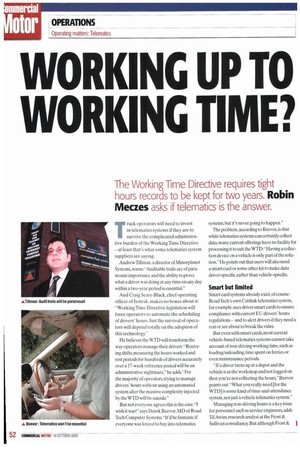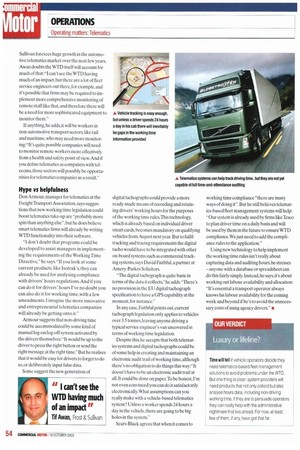The Working Time Directive requires tight
Page 52

Page 54

If you've noticed an error in this article please click here to report it so we can fix it.
hours records to be kept for tvvo years. Robin Meczes asKs if telematics is the answer.
Truck operators will need to invest in telematics systems if they are to survive the complicated administrative burden of the Working Time Directive — at least that's what some telematics system suppliers are saving.
Andrew Tillman, a director of Minorplanet Systems, warns:"Auditable trails are of paramount importance and the ability to prove what a driver was doing at any time on any day within a two-year period is essential."
And Craig Sears-Black, chief operating officer of Isotrak. makes no bones about it: "Working Time Directive legislation will force operators to automate the scheduling of drivers' hours. Just the survival of operators will depend totally on the adoption of this technology."
He believes the WTD will transform the way operators manage their drivers:"Rostering shifts,measuring the hours worked and rest periods for hundreds of drivers accurately over a 17-week reference period will be an administrative nightmare." he adds."For the majority of operators, trying to manage drivers' hours without using an automated system after the massive complexity injected by the WTD will be suicide."
But not everyone agrees this is the case."I wish it was!says Derek Beevor.MD of Road Tech Computer Systems. "it'd be fantastic if everyone was forced to buy into telematics systems, but it's never going to happen."
The problem. according to Beevor. is that while telematics systems can certainly collect data, many current offerings have no facility for processing it to suit the WTD:"Having a collection device on a vehicle is only part of the solution."He points out that users will also need a smart card or some other kit to make data driver-specific, rather than vehicle-specific.
Smart but limited
Smart card systems already exist, of course: Road Tech's own Cablink telematics system, for exam ple.uses driver smart cards to ensure compliance with current EU drivers' hours regulations— and to alert drivers if they need a rest or are about to break the rules.
But even with smart cards, most current vehicle-based telematics systems cannot take account of non-driving working time, such as loading/unloading,time spent on ferries or even maintenance periods.
"If a driver turns up at a depot and the vehicle is in the workshop and not logged on then you're not collecting the hours," Beevor points out. "What you really need [for the WTD] is some kind of time-and-attendance system, not just a vehicle telematics system."
Managing non-driving hours is a key issue for personnel such as service engineers, adds TAAwan, research analyst at the Frost & Sullivan consultancy. But although Frost & I Sullivan foresees huge growth in the automotive telematics market over the next few years. Awan doubts the WTD itself will account for much of that:"I can't sec the WTD having much of an impact. but there are a lot of fleet service engineers out there, for example. and it's possible that firms may be required to implement more comprehensive monitoring of remote staff like that, and therefore there will be a need for more sophisticated equipment to monitor them."
If anything. he adds, it will he workers in non-automotive transport sectors, like rail and maritime. who may need more monitoring:"It's quite possible companies will need to monitor remote workers more effectively from a health and safety point of viewAnd if you define telematics as computers with telecoms. those sectors will possibly be opportunities for telematics companies as a result.
Hype vs helpfulness Don Armour, manager i or telematics at the FreightTransport Association, says suggestions that new working time legislation could boost telematics take-up are -probably more spin than anything else". but he does believe smart telematics firms will already be writing WTD functionality into their software.
"1 don't doubt that programs could be developed to assist managers in implementing the requirements of the Working Time Directive." he says. "If you look at some current products. like Isotrak's, they can already be used for analysing compliance with drivers' hours regulations. And if you can do it for drivers' hours I've no doubt you can also do it for working time, with a few amendments. I imagine the more innovative and entrepreneurial telematics companies will already be getting onto it.
Armour suggests that non-driving time could be accommodated by some kind of manual log-on/log-off system activated by the drivers themselves: -It would be up to the driver to press the right button or send the right message at the right time." But he realises that it would be easy for drivers to forget to do so, or deliberately input false data.
Some suggest the new generation of digital tachographs could provide a more ready-made means of recording and retaining drivers' working hours for the purposes of the working time rules.This technology, which is already based on individual driver smart cards, becomes mandatory on qualifying vehicles from August next year. But to fulfil tracking and tracing requirements the digital tacho would have to be integrated with other on-board systems such as commercial tracking systems, says David Faithful, a partner at Amery-Parkes Solicitors.
"The digital tachograph is quite basic in terms of the data it collects," he adds.-There's no provision in the EU digital tachograph specification to have a GPS capability at the moment,for instance."
In any case, Faithful points out, current tachograph legislation only applies to vehicles over 3.5 tonnes. leaving anyone driving a typical service engineer's van uncovered in terms of working time legislation.
Despite this, he accepts that both telematics systems and digital tachographs could be of some help in creating and maintaining an electronic audit trail of working time. although there's no obligation to do things this way:"It doesn't have to be an electronic audit trail at all. It could be done on paper.To be honest, I'm not even convinced you can do it satisfactorily electronically. What assumptions can you really make with a vehicle-based telematics system? Unless a worker spends 24 hours a day in the vehicle, there are going lobe big holes in the system.
Sears-Black agrees that when it comes to working time compliance "there are many ways of doing it". But he still believes telematics-based fleet management systems will help: "Our system is already used by firms like Tesco to plan driver time on a daily basis and will be used by them in the future to ensure WTD compliance.We just need to add the compliance rules to the application."
Using new technology to help implement the working time rules isn't really about capturing data and auditing hours, he stresses anyone with a database or spreadsheet can do this fairly simply. Instead, he says, it's about working out labour availability and allocation: "It's essential a transport operator always knows his labour availability for the coming week and beyond if he's to avoid the unnecessary costs of using agency drivers." •
































































































































































































